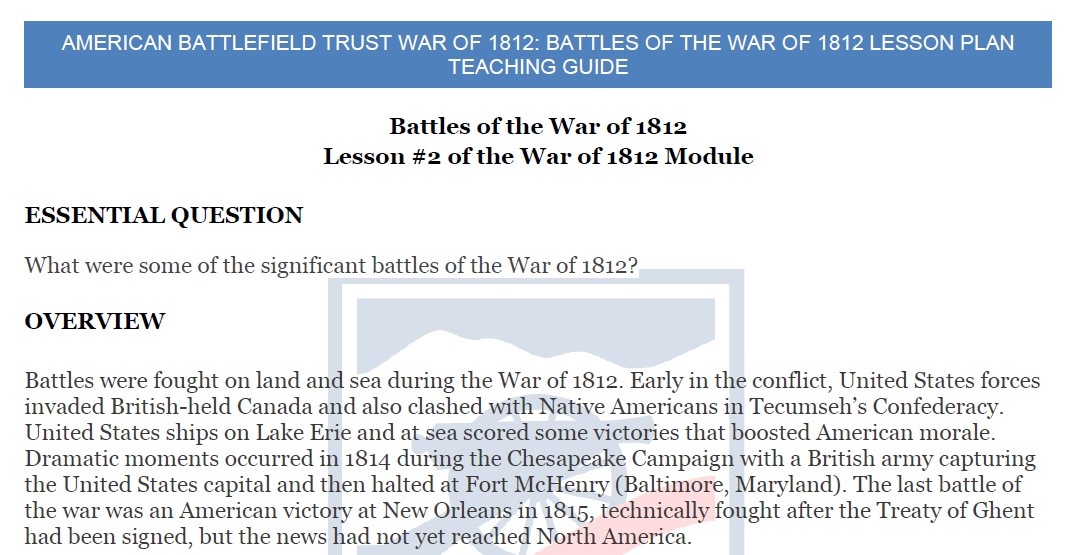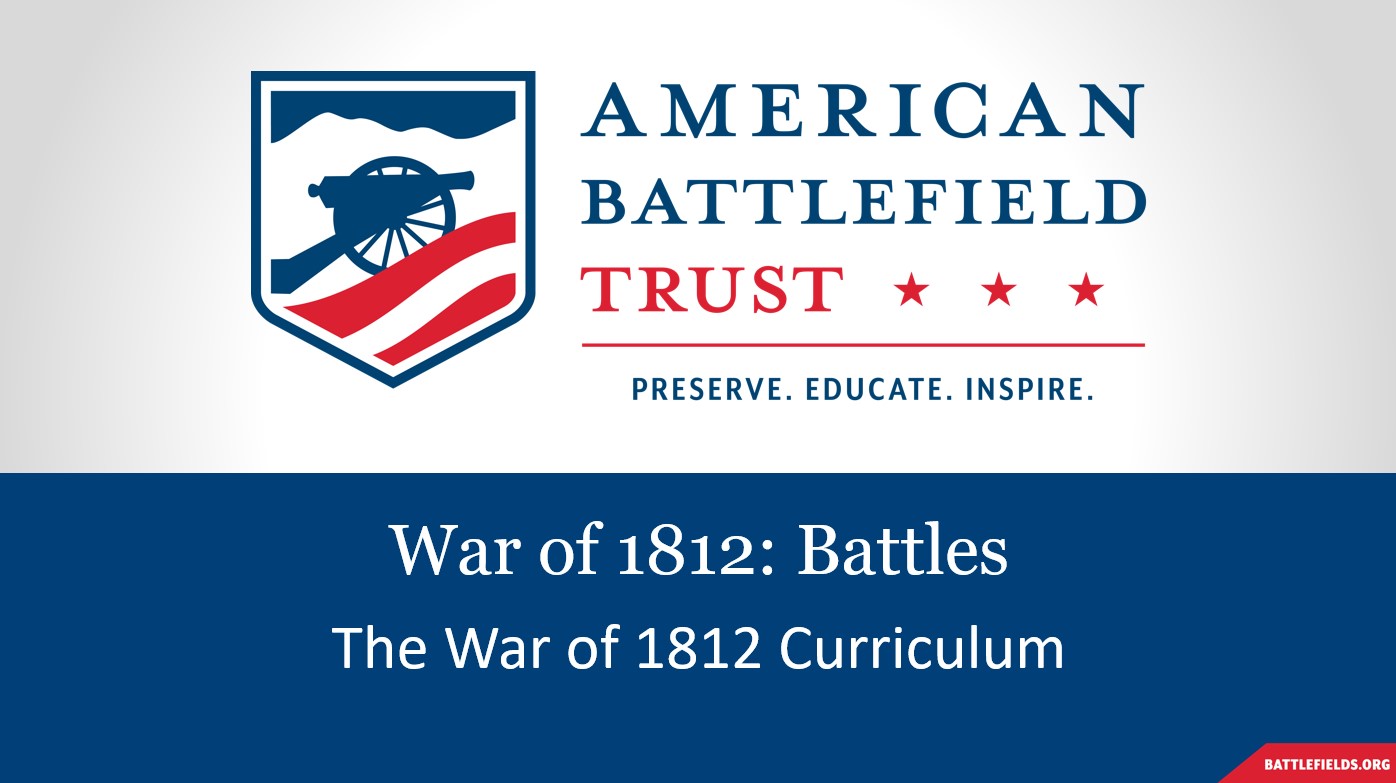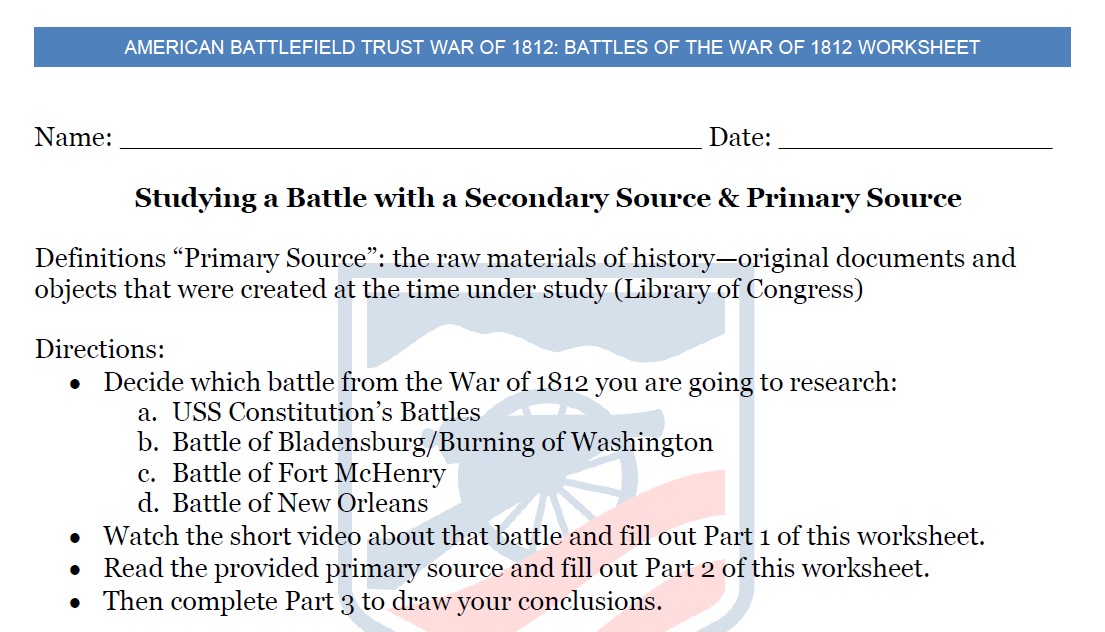
Battles of the War of 1812 Lesson Plan
A lesson plan for use in middle and high school classrooms.
Battles were fought on land and sea during the War of 1812. Early in the conflict, United States forces invaded British-held Canada and also clashed with Native Americans in Tecumseh’s Confederacy. United States ships on Lake Erie and at sea scored some victories that boosted American morale. Dramatic moments occurred in 1814 during the Chesapeake Campaign with a British army capturing the United States capital and then halted at Fort McHenry (Baltimore, Maryland). The last battle of the war was an American victory at New Orleans in 1815, technically fought after the Treaty of Ghent had been signed, but the news had not yet reached North America.
This Lesson Plan can be used as a prepared resource by following this curriculum plan which aligns to NCSS and Common Core Standards.
This Lesson Plan's assets can also be used on their own as supplemental resources. The display format is prepared for easy access, exploring, and learning.
Overview of the War of 1812 Module
Upon completion of this lesson, the students will be able to:
1. Knowledge
- Name and explain the outcomes of some of the battles of the War of 1812.
2. Comprehension/Application/Analysis
- Examine a secondary and primary source about a War of 1812 battle and analyze findings.
3. Evaluation
- Evaluate and discuss some of the battles during the War of 1812 and how they impacted the Americans, British, or Native Americans and their causes.
Check out the Lesson Plan Teaching Guide for more instructions on using the prepared Lesson Plan.
Lesson Plan Primary Source Activity:
- Use the Lesson’s PowerPoint to explore the context and history; the PowerPoint introduces Essential Questions and lays foundational knowledge about the battles.
- Let students decide which battle to study. This could be in a group, as a class, or individually. It can be done as written work sheets or as verbal discussion. (If the students are interested in a different battle not included on the list, there are additional resources available in the PowerPoint notes or on the American Battlefield Trust website: www.battlefields.org )
- Distribute the primary source worksheet.
- Watch one of or all of these short battle videos and have the students fill out Part 1 of their worksheet.
- Have the students read the primary source related to their chosen battle and fill out Part 2 of their worksheet. 7 selected primary sources are available under the “Primary Source” section of this lesson plan page.
- Finally, the students will fill out Part 3 of their worksheet to compare the Secondary Source (video) and the Primary Source and draw their conclusions.
OPTIONAL HOMEWORK/ASSESSMENT/ADDITIONAL ACTIVITIES:
Option 1: Biographies
Have the students select a historical person connected to the War of 1812. (There are 7 biography articles already prepared on the Lesson Plan Page). The students will read the biography and make notes for the following topics. Students can write a short essay, share their findings verbally, or incorporate their findings into a larger class project that might include art, costumes, or props.
Key Life Events:
Identify and describe three key events or milestones in the life of the individual. How did these events shape or influence their character, achievements, or contributions?
Legacy and Impact:
Reflect on the individual's lasting legacy and impact on society. What are the person's major contributions or accomplishments? Do you think these accomplishments were good? How have their actions influenced the course of history or inspired others?
Option 2: War of 1812 Artifacts
Have students watch this video: Artifacts from Fort McHenry Students can note WHAT the object is? HOW it was used? WHERE it was used? WHO used it? WHY is it important?
Common Core State Standards- ELA & History/Social Studies
Grades 6-8
- Key Ideas & Details:
- CCSS.ELA-LITERACY.RH.6-8.1
- Cite specific textual evidence to support analysis of primary and secondary sources.
- CCSS.ELA-LITERACY.RH.6-8.2
- Determine the central ideas or information of a primary or secondary source; provide an accurate summary of the source distinct from prior knowledge or opinions.
- CCSS.ELA-LITERACY.RH.6-8.1
- Craft and Structure:
- CCSS.ELA-LITERACY.RH.6-8.6
- Identify aspects of a text that reveal an author's point of view or purpose (e.g., loaded language, inclusion or avoidance of particular facts).
- CCSS.ELA-LITERACY.RH.6-8.6
- Integration of Knowledge and Ideas:
- CCSS.ELA-LITERACY.RH.6-8.9
- Analyze the relationship between a primary and secondary source on the same topic.
- CCSS.ELA-LITERACY.RH.6-8.9
Grades 9-10
- Key Ideas & Details:
- CCSS.ELA-LITERACY.RH.9-10.1
- Cite specific textual evidence to support analysis of primary and secondary sources, attending to such features as the date and origin of the information.
- CCSS.ELA-LITERACY.RH.9-10.2
- Determine the central ideas or information of a primary or secondary source; provide an accurate summary of how key events or ideas develop over the course of the text.
- CCSS.ELA-LITERACY.RH.9-10.1
Craft and Structure:
- CCSS.ELA-LITERACY.RH.9-10.6
- Compare the point of view of two or more authors for how they treat the same or similar topics, including which details they include and emphasize in their respective accounts.
- CCSS.ELA-LITERACY.RH.9-10.6
- Integration of Knowledge and Ideas:
- CCSS.ELA-LITERACY.RH.9-10.9
- Compare and contrast treatments of the same topic in several primary and secondary sources.
- CCSS.ELA-LITERACY.RH.9-10.9
Grades 11-12
- Key Ideas & Details:
- CCSS.ELA-LITERACY.RH.11-12.2
- Determine the central ideas or information of a primary or secondary source; provide an accurate summary that makes clear the relationships among the key details and ideas.
- CCSS.ELA-LITERACY.RH.11-12.2
- Craft and Structure:
- CCSS.ELA-LITERACY.RH.11-12.6
- Evaluate authors' differing points of view on the same historical event or issue by assessing the authors' claims, reasoning, and evidence.
- CCSS.ELA-LITERACY.RH.11-12.6
- Integration of Knowledge and Ideas:
- CCSS.ELA-LITERACY.RH.11-12.9
- Integrate information from diverse sources, both primary and secondary, into a coherent understanding of an idea or event, noting discrepancies among sources.
- CCSS.ELA-LITERACY.RH.11-12.9
Social Studies - National Council for the Social Studies
- Theme 2: Time, Continuity, and Change
- Theme 3: People, Places, and Environments
- Theme 5: Individuals, Groups, and Institutions
- Theme 6: Power, Authority, and Governance
- Theme 9: Global Connections
This Lesson plan
contains the following:
3 Activities | 26 Resources
Audience: Middle school | High school






